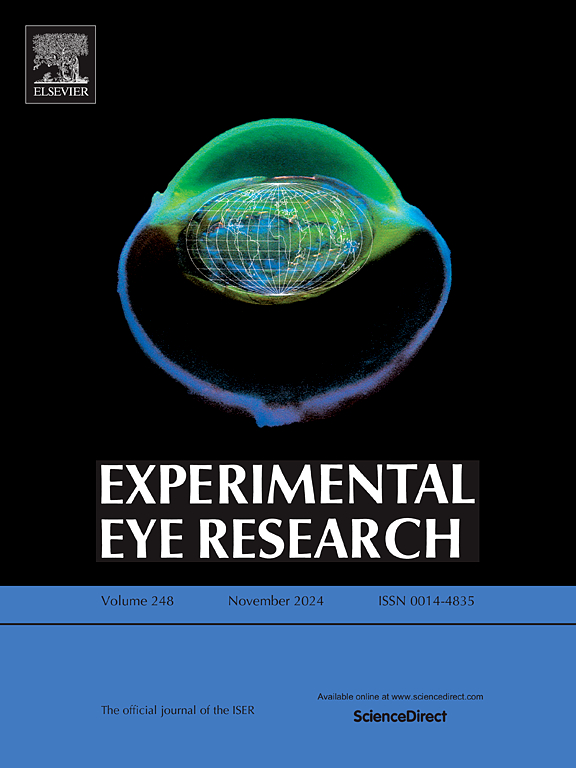TGF-β1 介导的 LMCD1 上调驱动角膜肌成纤维细胞分化和角膜纤维化。
IF 3
2区 医学
Q1 OPHTHALMOLOGY
引用次数: 0
摘要
转化生长因子β1(TGF-β1)能促使角膜成纤维细胞分化为角膜肌成纤维细胞,并在角膜纤维化中发挥关键作用。然而,LIM 和富含半胱氨酸结构域-1(LMCD1)在 TGF-β1 诱导的角膜肌成纤维细胞分化和角膜纤维化中的作用仍不明确。因此,本研究旨在探讨LMCD1在TGF-β1诱导的角膜肌成纤维细胞分化和角膜纤维化中的表达、调控机制和作用。通过mRNA测序、定量PCR(qPCR)和Western印迹检测发现,LMCD1在TGF-β1刺激的角膜成纤维细胞中表达上调。此外,通过 qPCR 和 Western 印迹检测,还发现 LMCD1 在角膜纤维化小鼠模型中上调。此外,我们的研究结果表明,TGF-β1 诱导的角膜成纤维细胞中 LMCD1 表达的增加主要受 SMAD3 信号通路的调控。此外,敲除 LMCD1 能显著抑制 TGF-β1 诱导的角膜成纤维细胞向肌成纤维细胞分化,并通过促进 TGF-β1 转录同时激活 SMAD3、JNK 和 p38。这些发现共同表明,在角膜肌成纤维细胞分化过程中,LMCD1可上调α-平滑肌肌动蛋白(α-SMA)的表达,下调TGF-β1的表达。因此,上调LMCD1的表达有可能成为介导角膜肌成纤维细胞分化和角膜纤维化过程中TGF-β1信号通路的一种策略,为角膜纤维化奠定理论参考,并有助于制定有效的角膜纤维化治疗策略。本文章由计算机程序翻译,如有差异,请以英文原文为准。
TGF-β1-mediated upregulation of LMCD1 drives corneal myofibroblast differentiation and corneal fibrosis
Transforming growth factor β1 (TGF-β1) drives corneal fibroblasts to differentiate into corneal myofibroblasts and plays a key role in corneal fibrosis. However, the role of LIM and cysteine-rich domains-1 (LMCD1) in TGF-β1-induced corneal myofibroblast differentiation and corneal fibrosis remains elusive. Thus, this study aimed to investigate the expression, regulatory mechanism, and role of LMCD1 in TGF-β1-induced corneal myofibroblast differentiation and corneal fibrosis. The expression of LMCD1 in TGF-β1-stimulated corneal fibroblasts was found to be upregulated through mRNA sequencing, quantitative PCR (qPCR), and Western blotting. Moreover, LMCD1 was identified to be upregulated in a mouse model of corneal fibrosis via qPCR and Western blotting. Additionally, our results demonstrated that the increase in LMCD1 expression induced by TGF-β1 in corneal fibroblasts was primarily regulated by the SMAD3 signaling pathway. Furthermore, LMCD1 knockdown significantly inhibited TGF-β1-induced corneal fibroblast-to-myofibroblast differentiation and simultaneously activated SMAD3, JNK, and p38 by promoting TGF-β1 transcription. These findings collectively suggest that LMCD1 could upregulate alpha-smooth muscle actin (α-SMA) expression and downregulate TGF-β1 expression in corneal myofibroblast differentiation. Consequently, upregulation of LMCD1 expression could potentially serve as a strategy to mediate the TGF-β1 signaling pathway in corneal myofibroblast differentiation and corneal fibrosis, laying a theoretical reference for corneal fibrosis and contributing to the development of effective therapeutic strategies for corneal fibrosis.
求助全文
通过发布文献求助,成功后即可免费获取论文全文。
去求助
来源期刊

Experimental eye research
医学-眼科学
CiteScore
6.80
自引率
5.90%
发文量
323
审稿时长
66 days
期刊介绍:
The primary goal of Experimental Eye Research is to publish original research papers on all aspects of experimental biology of the eye and ocular tissues that seek to define the mechanisms of normal function and/or disease. Studies of ocular tissues that encompass the disciplines of cell biology, developmental biology, genetics, molecular biology, physiology, biochemistry, biophysics, immunology or microbiology are most welcomed. Manuscripts that are purely clinical or in a surgical area of ophthalmology are not appropriate for submission to Experimental Eye Research and if received will be returned without review.
 求助内容:
求助内容: 应助结果提醒方式:
应助结果提醒方式:


